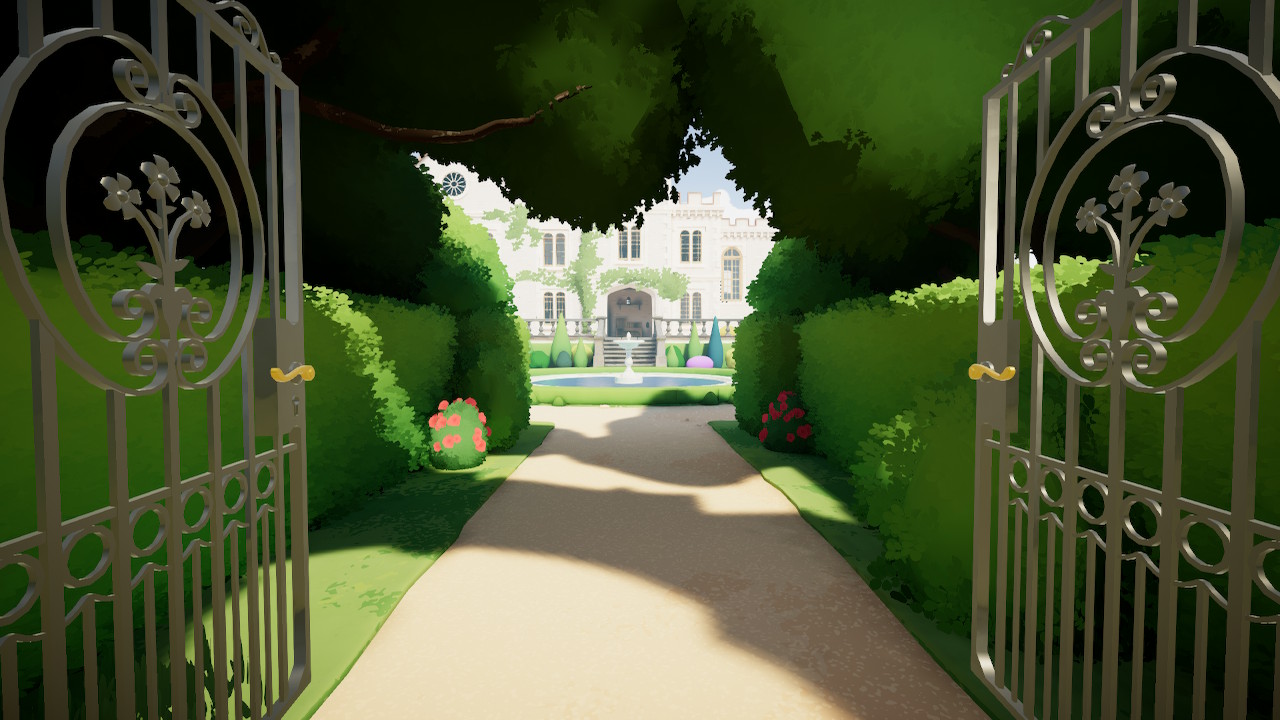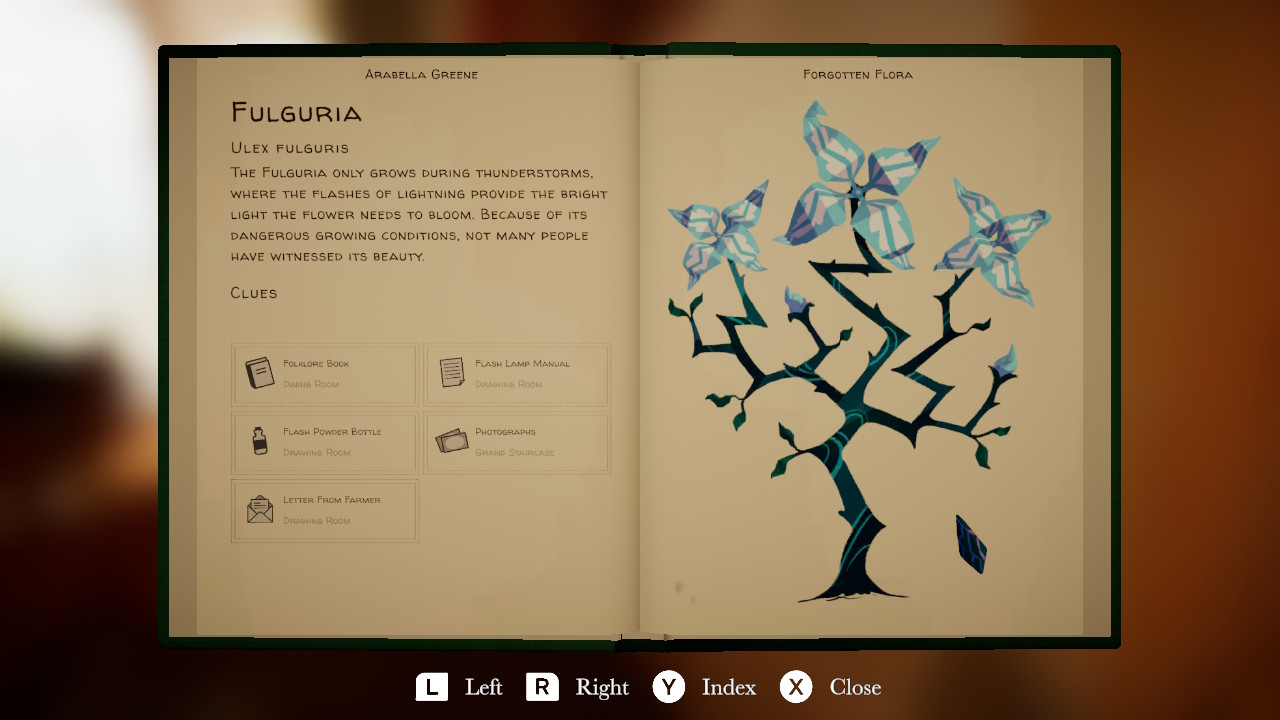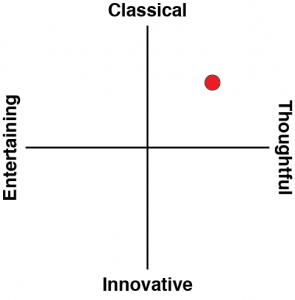Full disclosure: I have no semblance of a green thumb. Sometimes it feels like I can just look at plants and kill them. I think that’s why I have come to appreciate games with/about gardening in any capacity: I use video games as an escape, and escaping to something you can’t actually do in real life is the entire point. That brings me to Botany Manor, a cozy puzzle game about a newly-retired botanist continuing her work at her lovely (and large) manor. I was a bit worried that my brain couldn’t handle the puzzles or that I’d struggle physically but there was very little of that. Instead, I found a soothing place where observation and a bit of patience is all you need to succeed.
It is 1890 and botanist Arabella Greene has recently retired; though I use the term ‘retired’ loosely. She sets off for her manor in Somerset (England) to complete her book, Forgotten Flora. There’s an awful lot of information to fill in before the publisher will accept it, so Arabella best get to work. The narrative isn’t told directly, rather it is pieced together from clues that aren’t from the plants; clues like a family tree, a letter from her sister, and a decades-old letter rejecting her from university because she is a woman. I much prefer the ability to slowly about learn Arabella’s past rather than having it dropped all at once.
Botany Manor is kind of a cross between a walking sim and a puzzle game. There’s no combat. All you do is wander around the manor searching for items of interest and put the clues together to grow plants. You know an item should be looked at when a little white dot appears on or over it when you get close (most of the time, anyway – the chairs and couches you can sit on provide no information). The game features five chapters and for each, certain plants’ pages to be completed. Areas you don’t need until the future are closed off, helping narrow the search for seeds and clues. These places usually open with the help of a key that can be found exactly when you’re about to need it. It’s quite well planned. I live in a world of chaos, and knowing that I can sit down with a game fully trusting that the developer follows a logical path gives me great comfort.
There are potting stations found around the manor and its grounds. Potting stations contain the items required to grow any plant: pots, seeds, soil, and water are at your disposal. To me, a new potting station practically screams “you’ll come upon a new plant puzzle soon.” Sometimes clues for multiple plants to kind of mingle a bit. Completing a puzzle (successfully growing a plant) involves potting and various other steps found by searching the area some more, putting them into action using objects scattered about. The puzzles get more difficult as you progress, starting at three clues per plant and growing (ha) from there.
Clues sometime seem irrelevant but I promise you, they’re not. Every clue has a specific purpose, which is why I wish there was a way to see your clues again without needing to tediously run all over the place to reference anything. I’ve been taking screenshots of everything to make it slightly easier to access information. Even having a current location marker on the map could make this simpler since where the clue was found is stated in the book. Granted, it is in a small, light font that’s difficult to read in some situations so it would still be a struggle – just a different kind.
Here’s an example of growing one plant, Fulguria. I had to find five clues in three locations, plus the seeds. There were photographs in the Grand Staircase; a folklore book in the dining room; and a flash lamp manual, a flash powder bottle, and a letter from a nearby farmer. There were definitely times that my brain went out to lunch, like when I was trying trying to calculate exact ratios for a flask that clearly had marked sections on it or when I spent five minutes attempting to get the contents of said flask into the bottle when all I needed to do was empty the flask in the flash. Take the photo and ta-da! A fancy flower! The game is basically all this, but with a little more each time.
Last week, a video showcasing Botany Manor’s gameplay was released. Balloon Studios’ creative director Laure De Mey is the navigator and narrator as we follow Arabella trying to grow Pixie Tears. I tried to make my own gameplay video for Fulguria, but trust me when I say nobody wants to see me wander aimlessly for way too long while jerkily moving the camera around. So, just above, is the aforementioned gameplay trailer instead.
I haven’t even gotten to the best part of the gameplay: there are no time limits. For anything. Ever. Time limits stress me out and the same thing always happens: I play worse than I might otherwise, get frustrated, and quit. It’s happened dozens of times at this point (I’m way understating that number) so I’m all for games that can’t give me that frenzied feeling. Actually, thinking about it, I’m never mad at this game. Ever. Normally if I get stuck I’ll try for about two minutes then make my husband do it. With Botany Manor there is none of that anger or need to put down the controller. It’s like mindfulness; you can notice your thoughts of frustration, let them float away, and move forward. The game does this by gently prodding you in the right direction – without time constraints.
The world of Botany Manor is beautifully crafted. It is clear that a lot of heart went into the game, and it pays off. The music and sound effects work harmoniously with the game’s visuals. A little tune will play when you enter an area for the first time. When you’re outside, birds will chirp and you can practically smell the outdoors surrounding you. It is so serene. The game looks great on a big screen and it looks great playing handheld on an OLED screen. Everything is well-sized and readable. Well, almost… those darned clue locations in the book are difficult to see on a small screen. The UI is clear, and includes a page stating the controls (I always immediately forget these, so thank you). If you open the options menu, it goes back to when you were last there. So if you decide you don’t like a change you made, it’s super easy to undo. I did this about a hundred times when deciding whether or not I wanted the crosshairs (turns out, I did).
Botany Manor’s developer and publisher – Balloon Studios and Whitethorn Games, respectively – have put great care into making sure as many people as possible can play the game without difficulty. I struggle most with chronic pain, chronic migraines, and chronic distraction (AKA ADHD). Right off the bat, I found myself grateful for a coule of the multiple options to help reduce motion sickness: the vignette mode and the option to “blink” to clues (rather than swaying the camera while getting close) were especially effective for me. I also turned on the option to toggle (rather than holding) for running and messed with the camera sensitivity slider to make the controls feel “right.” Other accessibility features include (but are not limited to) supporting single stick gameplay, plain text overlays with a near-black background for clues, a crosshair toggle, and a crosshair size slider. Physically, everything in Botany Manor was peachy keen for me.
Unfortunately, I did struggle a bit with the mental aspects of the game. The first item you need to pick up slowly pulses with a glow, and I hoped that glow would be permanent because I always overlook items. It was not. The abilities to read clues without returning to them and to see your location on the map, which I mentioned earlier, also might have made things better. I can try to memorize two words for ten minutes and it will only take me 30 seconds to forget them, so I am forever getting lost in the manor and on the grounds. The game wasn’t ruined or anything, it just slowed me down. I suppose when I say “better,” what I actually mean more efficient for those us forgetful folk.
Cozy means something different to everyone. For me, a cozy game is about a welcoming atmosphere, no death, and a slow pace. That description fits Botany Manor to a tee. The world is so lovingly crafted, the grounds so abundant and colourful, that I’d like to stay there forever. I have screenshots of every room I’ve been in because they are perfectly decorated from every angle. The logical puzzles require careful observation (and sometimes backtracking once or twice) yet are somehow simultaneously quite straightforward. Botany Manor is exactly the kind of cozy puzzle/gardening sim that I’ve always wanted, save for a couple small bothers. I’m already eagerly anticipating my return to the manor.
Buy the hottest games with Amazon.
By purchasing from this link, you support DDNet.
Each sale earns us a small commission.













